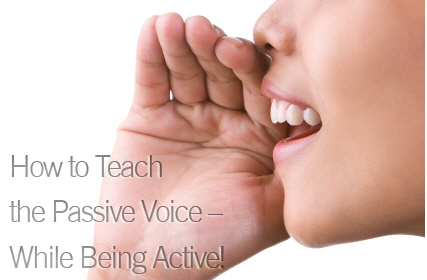How to Teach Passive Voice


Students need to be as “active” as ever and fully engaged in their learning. But it is the teacher who must engage them. How do you get students actively engaged in learning something as tedious as the passive voice? With action, of course! By showing them that there is plenty of action involved - action, typically meaning to achieve an aim - but that the focus is not on the actor, the one who is carrying out the action, but rather whoever or whatever is acted upon.
The passive voice is used regularly in both spoken and written language, despite the fact we often write in the active voice. It is therefore important to teach learners the difference between the active and passive voice and how to construct passive voice sentences.
These steps are one of the best ways to teach the passive voice:
Carry out an action!
Stand in front of your class. Drop a pen on the floor. Ask your students to tell you what has just happened and ask them to begin the sentence with your name. Someone should be able to say: “Ms. Rodriguez dropped a pen on the floor.” Write this sentence on the board. Ask students to identify the subject and the verb in this sentence; they should say the subject is “Ms. Rodriguez” and that the verb is “dropped”.
Repeat the action - Introduce the passive voice
Drop your pen on the floor one more time. Tell your students that you’ll tell them what has just happened, but this time your sentence will begin with, “The pen…” Go to the board and write, “The pen was dropped on the floor.” Ask your students to identify the subject; they should say it is the “pen”. Ask them to identify the verb; they should say it is “was dropped”.
Compare the two sentences
Point to the first sentence and ask if the subject is doing the action. They should say it is. Make sure they understand that subject is active, the one responsible for carrying out the action.
Point to the second sentence and ask if the subject is doing the action. They should it isn’t. Make sure they understand that the subject is passive, the one who is being acted upon.
Compare what happens to the verbs. Ask students what tense they see in the first example. They should recognize the past simple. Show students what happens in the second sentence: the auxiliary verb “to be” is used in the past tense (“was”) with the past participle, in this case “dropped”.
Give an example using the word “were"
This time drop several pens at the same time. Ask students to tell you what has just happened. Tell them to start the sentence with “The pens…” See if students figure out they should use “were” instead of “was” this time.
Practice with more passive voice examples
Carry out more actions and encourage students to describe what has happened in the passive voice:
Teacher puts some books under a chair.
S: Books were put under a chair.
Teacher closes a book.
S: A book was closed.
Teacher writes some words on the board.
S: Some words were written on the board.
Teacher we leave school at 3.00 o'clock.
S: We left school at 3.00 o'clock.
Teacher writes some words on the board.
S: Some words were written on the board.
Give enough examples to make students comfortable with the use of the past simple in the passive voice.
Practice the passive voice with negative statements
Continue carrying out actions around the classroom, but this time challenge students to make negative statements followed by affirmative statements:
Teacher drops some papers on the floor.
S: Pens weren’t dropped on the floor. Papers were dropped.
Teacher closes a door.
S: A window wasn't closed. A door was closed.
Practice questions in the passive voice
Carry out actions and have students ask questions:
Teacher opens a window.
S: Was the window opened? What was (just) opened?
Place the passive voice in a real-life context - Discussion
Ask students to brainstorm the types of things that the government does for the population. The government repairs streets, cleans monuments, builds schools and hospitals, etc...Make sure students see that sometimes when we talk about actions, we’re not interested in the actor, either because we know who it is (in this discussion we are clearly talking about the government), or because we'd like to emphasize the results, in other words what was accomplished. Discuss what things were done in the last year by the local government. Encourage students to use the passive voice.
S: Streets were repaired. A new hospital was opened. The park benches were painted. Trees were planted. Etc…
The passive voice focusses on in the person or object that experiences an action rather than the person or object that performs the action. In other words, the most important thing or person becomes the subject of the sentence.
Divide the class into two groups. Students from each group take turns to give a sentence describing an activity. A student from one group creates a sentence in the active voice about the activity, then a student in the second group says the sentence in the passive voice. Continue, giving other members of the group turns alternating from each voice. Assign different activities to each group. Some examples you can use:
Baking a cake.
Visiting the library.
Going to the movies.
Watching television.
Playing a game.
The same game can be played using other tenses.
Introduce the passive voice in other tenses; actions work very well with the present perfect, too (“Some books have just been put away”) – and don’t forget modals! For extended practice, be sure to go to our Passive Voice Section, where you’ll find a variety of worksheets to suit your teaching needs.